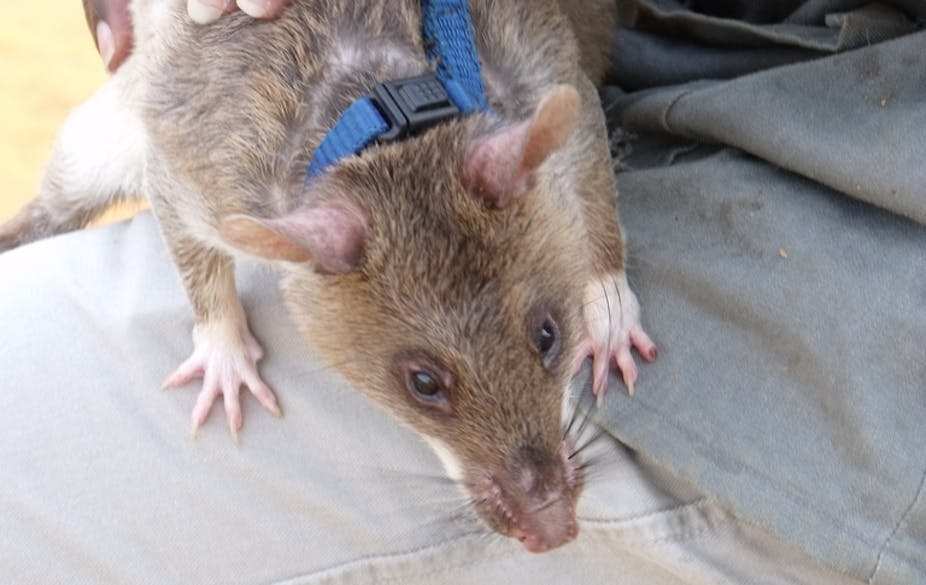When it comes to thinking about disease, rats are usually thought of as vermin that carry plague and pestilence. But what about rats being used to sniff out diseases such as tuberculosis in people’s saliva, or salmonella bacteria in contaminated food? Or what about “camerats” – back-packed with miniature cameras and wireless transmitters to find people trapped after disasters?
We’ve been exploring all of these. Rats trained to detect TB have already been deployed in Tanzania and Mozambique, with further potential in African countries that have seen an increase in cases since the advent of HIV. Accurate and efficient TB diagnosis is one of the most pressing health problems in many African countries, and it is something we’ve found rats are able to do particularly well. In Tanzania, about 26,000 saliva specimens of TB patients are now screened by rats annually in the capital Dar es Salaam.

African Giant Pouched Rats, or Cricetomys gambianus, are widely distributed in tropical Africa. In 2000, we began training these rats at Sokoine University in Tanzania to detect landmines. The sensitivity of rats is many times greater than that of dogs. And they are able to detect levels of TNT (used in landmines) which are much lower than could be detected by a machine.
Pavlov’s rat
Whether it is for TB diagnosis, salmonella or landmine detection, the training of a rat as biosensor works on a very basic principle, very similar to the Pavlovian response or classical conditioning: a rat is given a deactivated culture of Mycobacterium tuberculosis to sniff, for example, before being given a reward for finding a TB-positive specimen from a series arranged on a test board. Much as sniffer dogs do when they’re trained to find traces of drugs or missing people.
The rats are being used in Mozambique, which was left heavily laid with landmines following years of civil war, and at any given time we usually have between 15-20 animals in the field. The rats are now being used in Angola, and soon to be in Thailand and Cambodia. It is relatively safe for the rats and they are well cared for and get the attention of vets. They are replaced when they die naturally or due to unknown causes.
Seven sniffs a minute

Since they proved so successful in sniffing out mines, we wondered about what else they could do. So we began training them to diagnose Mycobacterium tuberculosis, the causative agent of TB in humans, using saliva samples.
Rats are very accurate and specific when doing this and are phenomenally fast at diagnosis. We’ve found that rats are able to identify the TB bacterium with more than 90% accuracy and are able to pick up 44% more positive cases than microscopy.
Initially, the medical community was sceptical about this technology, but backed by various scientific studies that rats can do this with a high level of accuracy the idea has caught on.
It takes about six months for a rat to complete the training and to be accredited for TB diagnosis. And a single accredited rat is able to diagnose 140-150 specimens in 20-25 minutes (which equates to six to seven specimens per minute). To give a sense of this speed, a laboratory technician using microscopy will work on about 40 specimens in an eight-hour working day.
However, the idea is to use the rats to compliment the work technicians, in particular because sometimes technicians report positive specimens as negative. Negative samples can be be double-checked by the rats.
They can also be deployed in more routine diagnoses where speed and accuracy can save lives. And in emergencies, for example when hundreds of thousands of people face a TB epidemic in refugee camps, the rats can be the only quick solution to identify patients of TB. At any given time we have a stock of trained rats ready for this purpose. Deploying them in this way would involve collecting saliva samples and getting them to the rats in the lab.
The number of patients being screened in this way is likely to increase in future as more and more health centres submit requests to use this biosensor technology. In addition to our rats at Sokoine, Apopo, a Belgian NGO that supports our work, has also built a special TB diagnosis laboratory at the Eduardo Mondlane University in Mozambique, which started operations in June last year.
Send in the camerats
What is the potential of using the rats in other disease situations? Well, we’re currently training them to detect Salmonella bacteria that causes diarrhoea, fever and vomiting when an individual consumes contaminated food. The training is quite advanced – there are several strains of Salmonella and at the moment we have been training the rats to detect four common strains with good progress – but we are still at the lab stage.
Another idea is to use the rats for rescue services in man-made or natural disasters. This is where “camerats” – again using African Giant Pouched Rats – come in. The idea is that using their equipped backpacks, they will be able to send images back of victims they find trapped in debris. Their small size will allow them to penetrate places where dogs cannot reach in the search for victims.
We are currently at simulation stage where we simulate a collapsed building with individuals trapped in it. What we need to establish is whether the rats are actively searching for individuals or if they are just finding them at random.
They are several advantages for using rats: they are low cost in maintenance, people don’t have the same emotional attachment as they do with dogs (and they have more sensitive smell), and their small size and faster growth mean they can start training much earlier.

